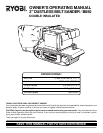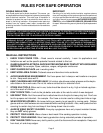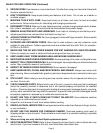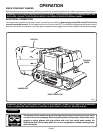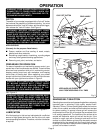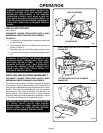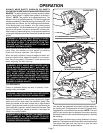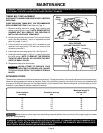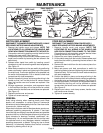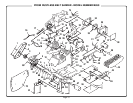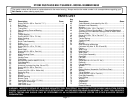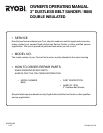
Page 5
OPERATION
WARNING: YOUR SANDER SHOULD NEVER BE
CONNECTED TO POWER SUPPLY WHEN YOU
ARE ASSEMBLING PARTS, CHANGING BELTS,
OR MAKING ADJUSTMENTS.
Fig. 2
SWITCH
The switch of your sander is equipped with a "lock-off" button
that reduces the possibility of accidental starting. You must
depress and hold the "lock-off" button, pull the switch trigger,
then release the "lock-off" button.
See Figure 2.
WARNING: BEFORE CONNECTING YOUR
SANDER TO POWER SUPPLY SOURCE, ALWAYS
MAKE SURE YOU DO NOT HAVE THE SWITCH
TRIGGER DEPRESSED IN THE "ON" POSITION.
FAILURE TO DO SO COULD RESULT IN
ACCIDENTAL STARTING OF YOUR SANDER
RESULTING IN POSSIBLE SERIOUS INJURY.
APPLICATIONS
(Use only for the purpose listed below)
■ Coarse, medium and fine sanding of wood, metals,
plastics and other materials.
■ Smoothing rough boards, chamfering, rounding edges
and many other general sanding applications.
■ Removing rust, paint, varnishes, and stains.
PREPARING FOR OPERATION
For ease of operation and maintaining proper control, your
sander has a front handle and a rear handle. These handles
allow two-hand operation which aid in maintaining control,
keeping sanding area level with workpiece, and keeping
hands clear of sanding belt. When operating your sander
always hold the front handle with your left hand and the rear
handle with your right hand as shown in Figure 2.
WARNING: KEEP HANDS AND FINGERS CLEAR
OF MOVING SANDING BELT, FRONT IDLER
PULLEY AND DRIVE ROLLER ASSEMBLY.
FAILURE TO DO SO WILL RESULT IN THE
SANDING OF YOUR HANDS OR FINGERS.
See Figure 3.
WARNING: DO NOT LET YOUR FINGERS REST
OVER THE FRONT OR RIGHT EDGE OF THE
SANDER. IF THE SANDING BELT WERE TO RUN
OFF, OR IF IT WERE NOT PROPERLY ADJUSTED,
YOUR FINGERS COULD COME IN CONTACT WITH
THE MOVING SANDING BELT RESULTING IN
POSSIBLE SERIOUS INJURY.
Always operate your sander as shown in Figure 2.
Fig. 3
SANDING BELT SELECTION
Selecting the correct size and type sanding belt is an extremely
important step in achieving a high quality sanded finish.
Standard 75 mm x 534 mm sanding belts made of aluminum
oxide, silicon carbide, and other synthetic abrasives are best
for power sanding. In general, coarse grit will remove the
most material and fine grit will produce the smoothest finish
in all sanding operations. The condition of the surface to be
sanded will determine which grit belt will do the job. If the
surface is rough, start with a coarse grit and sand until the
surface is uniform. Medium grit may then be used to remove
scratches left by the coarser belt and fine grit belt used for
finishing of the surface. Always continue sanding with each
grit belt until surface is uniform.
LUBRICATION
All of the bearings in this tool are lubricated with a sufficient
amount of high grade lubricant for the life of the unit under
normal operating conditions. Therefore, no further lubrication
is required.
LOCK "OFF" BUTTON
REAR HANDLE
FRONT HANDLE
KEEP HANDS AND FINGERS
AWAY FROM THESE AREAS AT ALL TIMES



